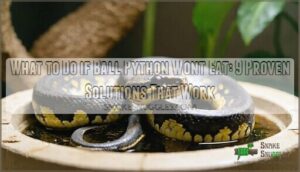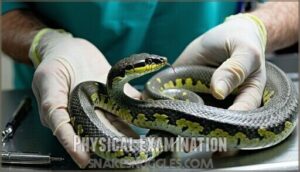This site is supported by our readers. We may earn a commission, at no cost to you, if you purchase through links.
 When figuring out what to do if ball python won’t eat, start with the basics. Check your temperatures – they need 88-92°F on the warm side and 78-80°F on the cool side.
When figuring out what to do if ball python won’t eat, start with the basics. Check your temperatures – they need 88-92°F on the warm side and 78-80°F on the cool side.
Stop handling your snake completely until it resumes eating, as stress kills appetite. Try switching prey types from mice to rats or vice versa. Feed in their home enclosure rather than moving them elsewhere.
Ball pythons are notorious for seasonal fasting, especially during winter months, so don’t panic if they’re otherwise healthy. Most importantly, monitor their weight weekly – a 10% loss signals trouble.
The secret lies in understanding their wild instincts.
Table Of Contents
- Key Takeaways
- What to Do if Ball Python Wont Eat?
- Understanding Ball Python Feeding Behavior
- Common Reasons for Feeding Refusal
- Assessing Your Ball Python’s Health
- Optimizing Husbandry Conditions
- Proper Feeding Techniques
- Encouraging Reluctant Feeders
- When to Seek Veterinary Care
- Long-term Management Strategies
- Frequently Asked Questions (FAQs)
- What should I do if my ball python is not eating?
- Do ball pythons eat after shedding?
- Why don’t ball pythons eat?
- How long can a ball python go without eating?
- How do you get a ball python to eat?
- How do you get a ball python to feed again?
- What to do if a ball python refuses to eat?
- How can I get my ball python to eat?
- How do you know if your ball python is dying?
- What to do if a snake is struggling to eat?
- Conclusion
Key Takeaways
- Check your temperatures first – You’ll need 88-92°F on the warm side and 78-80°F on the cool side, as improper temperatures are the most common cause of feeding refusal in ball pythons.
- Stop handling completely until they resume eating – Stress kills appetite, so do not handle your snake at all during feeding strikes and ensure they have secure hiding spots on both temperature zones.
- Don’t panic during seasonal fasting – Ball pythons naturally refuse food for 2-6 months during winter or breeding season, especially October through March, which mimics their wild behavior patterns.
- Monitor weight weekly and watch for red flags – A 10% weight loss signals trouble, and you’ll need veterinary care if your snake shows respiratory distress, has not eaten for over 3 months, or displays other illness symptoms.
What to Do if Ball Python Wont Eat?
When your ball python not eating becomes a concern, don’t panic. Three key steps solve most python refusing food situations.
First, check your setup – proper temperature gradients and humidity levels are essential for appetite stimulation. Second, assess refusal causes like shedding cycles or seasonal fasting patterns.
Third, try different dietary preferences by warming prey or switching sizes. Excessive handling can also suppress appetite.
Monitor weight and behavior closely. Hydration importance can’t be overlooked either. If python eating problems persist beyond normal fasting periods, consider veterinary options for underlying health issues.
Understanding Ball Python Feeding Behavior
Ball pythons are naturally programmed ambush hunters that strike from hidden spots and can fast for months without harm, especially during cooler seasons.
You’ll need to understand their instinctual feeding patterns and seasonal changes to distinguish between normal behavior and actual feeding problems.
Natural Feeding Habits
Understanding your snake’s wild diet helps explain why captive feeding can be tricky.
Ball pythons are ambush hunting specialists who rely on patience and stealth. Their nocturnal behavior means they’re most active after sunset, using heat-sensing pits and smell to locate prey.
Snake feeding habits revolve around prey preference for small mammals like rats and mice. These natural feeding habits involve long waits between meals, sometimes weeks apart.
The senses used for hunting include thermal detection and chemical trails. A vital aspect involves understanding their ball python temperament, which can influence feeding behavior.
- Snake behavior tip: Feed your python during evening hours to match their natural hunting instincts
Seasonal Fasting Patterns
Your ball python’s natural rhythms don’t disappear in captivity.
Wild behavior patterns still influence when they’ll accept food throughout the year.
During breeding season (roughly October through March), many ball pythons enter what’s basically a hunger strike.
This brumation period mimics their African dry season, when food becomes scarce.
Don’t worry if your snake refuses meals for weeks during seasonal changes.
Temperature influence and humidity impact play major roles in triggering these fasting cycles.
A ball python not eating during winter months is completely normal behavior.
| Season | Feeding Pattern | Duration | Owner Action |
|---|---|---|---|
| Spring/Summer | Active feeding | 6-8 months | Regular schedule |
| Fall/Winter | Reduced appetite | 2-4 months | Monitor weight |
| Breeding Season | Frequent refusal | 3-6 months | Patience required |
| Post-Brumation | Gradual return | 2-3 weeks | Resume feeding |
Common Reasons for Feeding Refusal
Ball pythons refuse food for several predictable reasons that you can identify and address systematically.
Environmental stress, health problems, and seasonal changes account for most feeding strikes, and understanding these triggers helps you troubleshoot the issue effectively, by identifying complete concepts.
Environmental Stressors
Environmental factors can turn your ball python into a picky eater faster than you’d expect.
When your snake feels unsafe or uncomfortable, it’ll simply refuse food until conditions improve.
Common stressors include excessive Handling Frequency, inadequate Enclosure Size, poor Lighting Concerns like bright overhead bulbs, high Noise Levels, and frequent Cage Changes that disrupt their routine.
Your python needs consistent temperature gradients, proper humidity levels, and secure hides to feel safe enough to eat.
Think of it like trying to enjoy dinner while someone’s rearranging your furniture – pretty stressful, right?
- Pro tip: Wait at least 48 hours after any enclosure modifications before offering food, giving your snake time to settle into the new setup.
Remember, ball pythons are naturally solitary creatures who prefer predictable, quiet environments.
Health Issues
Sometimes your ball python’s feeding strike signals deeper snake health issues that need immediate attention.
Parasite infections can drain your pet’s energy and appetite completely. Respiratory issues make breathing difficult, reducing interest in food. Oral abscesses cause painful eating experiences that keep snakes away from meals. Impaired vision prevents them from recognizing prey properly. Shedding problems create discomfort that suppresses appetite.
When your ball python not eating extends beyond normal fasting periods, these health conditions require a veterinarian’s expertise to diagnose and treat effectively. Veterinary teletriage services can provide initial assessments for reptiles and other novel species.
Seasonal Changes
Just like you might lose your appetite during certain times of year, your snake experiences natural seasonal shifts that affect feeding.
Ball python appetite loss often coincides with winter brumation and breeding season cycles.
Your snake’s internal clock triggers these changes through:
- Temperature shifts that signal seasonal cycles
- Humidity fluctuation mimicking natural weather patterns
- Shedding cycle disruptions during hormonal changes
- Breeding season instincts overriding hunger drives
Assessing Your Ball Python’s Health
Before you try any feeding tricks, you need to rule out health problems that might be causing your ball python’s appetite loss.
A quick health check can save you weeks of frustration and help you decide whether it’s time to call a reptile vet.
Physical Examination
Give your ball python a thorough once-over to spot potential snake health issues. Start with Eye Examination – look for clear, bright eyes without cloudiness or discharge.
Check Nostril Clarity for any blockages or unusual secretions. Examine Scale Condition for smoothness and proper shedding.
Perform Hydration Assessment by gently pinching skin – it should snap back quickly. Use Body Scoring to evaluate overall condition, watching for weight loss or emaciation.
If you notice concerning signs, contact a snake veterinarian immediately for professional evaluation.
Weight Monitoring
Regular weight monitoring serves as your best early warning system for health issues.
Use a precise digital scale to weigh your ball python weekly, recording each measurement in a feeding log.
Compare these readings against ideal weight charts for your snake’s age and length to track proper growth rate.
Scale accuracy matters—invest in a quality gram scale for reliable data interpretation.
Sudden weight loss often signals your ball python not eating due to underlying problems, while steady gains indicate good health.
Body condition scoring alongside weight data gives you the complete picture of your snake’s nutritional status.
Behavior Observation
Vigilance is your best tool when observing your ball python’s behavior patterns. Watch your snake’s body language for normal coiling and comfortable positioning.
Check for neurological signs like head tilting or unusual tremors that might indicate illness. Feel your python’s muscle tone – it should feel firm, not limp or overly rigid. Monitor respiration rate by counting breaths per minute; healthy ball pythons breathe 4-8 times per minute at rest.
Notice tongue-flicking frequency, which shows environmental awareness and alertness. These subtle illness indicators often appear before obvious symptoms when your ball python’s not eating.
- Track daily activity levels, hiding preferences, and response to gentle handling to establish your snake’s normal behavior baseline for comparison, including monitoring for neurological signs and maintaining awareness of your python’s muscle tone and overall health.
Optimizing Husbandry Conditions
Poor housing conditions often trigger feeding strikes in ball pythons, making your snake’s environment the first place to check when appetite disappears.
You’ll need to verify that your temperature gradient stays consistent, humidity levels remain stable, and hiding spots provide proper security for your python to feel comfortable enough to eat.
Temperature Gradient
Your ball python needs the right temperature setup to digest food properly.
Temperature isn’t just comfort—it’s the key that unlocks your ball python’s appetite.
Create a temperature gradient with basking temperatures of 88-92°F on the warm side and cooler side temperatures of 78-80°F. Use reliable heat sources like ceramic emitters or heat panels with thermostat use for consistent control.
Check temperatures regularly with an infrared thermometer for accurate gradient monitoring. This thermal range mimics their natural habitat and kickstarts their appetite when everything else seems stuck.
A glass aquarium enclosure with a secure, ventilated top is often recommended for them.
Humidity Levels
Your ball python’s humidity needs mirror their African savanna home – aim for 50-60% to prevent shedding problems and respiratory health issues.
Low humidity often triggers feeding strikes since snakes feel stressed when their environment isn’t right.
A vital tool is a quality humidity gauge for monitoring.
- Humidity monitoring with a reliable hygrometer prevents guesswork
- Misting techniques using dechlorinated water maintain consistent levels
- Substrate choice like cypress mulch retains moisture naturally
Hiding Spots and Enclosure Setup
Proper humidity sets the stage, but your ball python not eating often stems from inadequate hiding spots and poor enclosure setup. Your snake needs two hides – one on each temperature zone – that feel like cozy caves, not open houses. The entrance should barely fit your python’s body, creating security that reduces stress.
Many keepers find quality python hides are essential for a snake’s well-being. Substrate choice matters too. Coconut husk retains moisture while aspen shavings offer burrowing opportunities. Your water source should be heavy enough to prevent tipping but shallow enough for easy access.
| Setup Element | Requirement | Impact on Feeding |
|---|---|---|
| Enclosure Size | 40+ gallons for adults | Prevents overcrowding stress |
| Hide Placement | Hot and cool sides | Reduces anxiety |
| Lighting Needs | Dim/natural cycle | Maintains circadian rhythm |
| Enrichment Items | Branches, fake plants | Provides mental stimulation |
| Temperature Zones | 88-92°F hot, 78-80°F cool | Enables proper digestion |
Proper Feeding Techniques
Getting your feeding technique right can make the difference between a snake that eats regularly and one that leaves you worried for weeks.
You’ll need to master three key areas: choosing the correct prey size and type, establishing a proper feeding schedule, and using effective presentation methods that trigger your ball python’s natural hunting instincts.
This includes understanding the importance of a proper feeding schedule and effective presentation methods to stimulate the snake’s appetite.
Prey Size and Type
Choosing the right prey size and type can make or break your feeding success.
Your ball python’s prey should match their widest body section – think girth, not length. Hatchling diets start with fuzzy mice, while adults handle large mice or small rats.
Proper prey sizing prevents digestive issues.
- Rodent variety matters: Experiment with mice versus rats to discover your snake’s prey preferences
- Frozen vs. live debate: Frozen-thawed prey offers safety and convenience while meeting nutritional needs perfectly
Feeding Schedule
Getting your feeding schedule right can make or break your ball python’s appetite. Consistency matters, but don’t panic if they skip meals during seasonal variation periods.
| Age Group | Feeding Frequency |
|---|---|
| Hatchlings | Every 5-7 days |
| Juveniles | Every 7-10 days |
| Adults | Every 10-14 days |
Wait 48 hours after regurgitation timing before offering food again. These ball python feeding tips help prevent snake feeding issues.
Presentation Methods
In regards to prey presentation, the right approach can turn your picky eater into an enthusiastic hunter.
Here are four proven methods:
- Live vs. Frozen: Start with frozen/thawed for safety, but live prey works for stubborn cases
- Warming Techniques: Heat prey to 100°F using warm water before offering
- Tongs Usage: Use feeding tongs for prey wiggling to simulate natural movement
- Scenting Options: Try chicken broth or braining techniques for reluctant feeders
These methods can be applied to improve the feeding experience and encourage natural hunting behavior.
Encouraging Reluctant Feeders
When your ball python consistently refuses food despite proper husbandry, you’ll need to employ specific techniques that make prey items more appealing and trigger their natural feeding response.
These methods work by enhancing scent trails, exposing brain matter, or providing gentle assistance during feeding attempts to help your snake overcome temporary feeding strikes, using techniques that make prey items more appealing and trigger their natural feeding response.
Scenting Prey Items
When standard feeding techniques fail, scenting your prey can work wonders.
Scenting Benefits include triggering your python’s hunting instincts through familiar odors. Rub prekilled prey or frozen prey with used rodent bedding, or dip it in chicken broth for Novel Scents.
Many owners find success using high-quality frozen rodents for scenting purposes. Scenting Methods vary – try gerbil litter, hamster bedding, or even a drop of tuna juice.
Scenting Alternatives include warming the prey to 100°F and wiggling it with tongs. Avoid Scenting Dangers like using soap-scented materials or overpowering odors that might repel rather than attract your snake.
Braining Techniques
When your snake not feeding becomes a persistent issue, braining techniques offer a last resort solution before assist feeding.
This method involves making a small, careful incision in the prey’s skull to enhance odor release and attract your ball python picky eater.
The exposed brain tissue creates stronger scents that can trigger feeding responses in even the most stubborn python not interested food.
Braining risks include potential contamination, so maintain strict hygiene throughout the process.
Warm the prey to 100°F and use feeding tongs to simulate natural movement.
While ethical considerations make this technique controversial, it’s proven effective for how to get python to eat.
Always try alternative scents first before resorting to braining methods.
Assist Feeding
When gentle methods fail, assist feeding becomes your final option.
This feeding technique requires veterinary guidance and extreme caution to avoid injury.
- Hold your snake’s head gently behind the jaw while supporting its body
- Insert prey at 45-degree angle using soft pressure on jaw sides
- Monitor breathing constantly and stop if distress occurs
- Limit frequency to once weekly to prevent feeding dependency
When to Seek Veterinary Care
Most feeding problems resolve with patience and proper husbandry adjustments, but you’ll need professional help when your ball python shows concerning symptoms beyond refusing food.
If your snake has lost more than 10% of its body weight, displays respiratory distress, shows signs of parasites, or hasn’t eaten for over three months, it’s time to schedule a vet visit before the situation becomes critical.
Prolonged Fasting
Prolonged fasting becomes a serious concern when your ball python’s hunger strike extends beyond normal limits.
Here’s when you should worry:
- Adults: No food for 2-3 months signals potential health risks
- Juveniles: Refusing meals for 3-4 weeks requires attention
- Hatchlings: Just 2 weeks without eating demands immediate action
- Weight loss: Any significant drop regardless of fasting duration
Extended hunger strikes create nutritional deficiencies and hydration concerns that can stunt growth.
Don’t play the waiting game – intervention strategies work best when you catch problems early.
Signs of Illness
Beyond prolonged fasting, certain red flags signal your ball python stopped eating due to serious health problems.
Watch for respiratory issues like wheezing, mouth breathing, or bubbly saliva around the nostrils. Lethargy signs include unusual inactivity or abnormal positioning that screams "something’s wrong."
Skin abnormalities such as stuck shed, mites, or unusual discoloration often accompany loss of appetite. Parasite symptoms like diarrhea or nasal discharge indicate internal problems.
If you notice visible spine or ribs alongside these warning signs, your snake needs immediate veterinary attention. Don’t wait—early intervention prevents minor issues from becoming life-threatening snake illness complications.
Weight Loss
Weight tracking becomes your best friend when your ball python stopped eating. Regular weigh-ins help spot trouble before it spirals out of control. Monitoring Methods should include weekly checks for visible spine or ribs, which indicate poor body weight loss conditions.
Identifying Causes of a ball python hunger strike requires noting when why wont my python eat questions arise. Here are key warning signs:
- 10-15% weight drop over several weeks
- Visible ribs or spine showing through skin
- Sunken eyes or wrinkled appearance
- Lethargy combined with appetite loss
Veterinary Consultation becomes necessary when Intervention Strategies and Dietary Adjustments fail to resolve the issue.
Long-term Management Strategies
Once you’ve successfully addressed your ball python’s immediate feeding issues, you’ll need to establish consistent practices to prevent future problems.
These long-term strategies focus on maintaining detailed records, providing dietary variety, and creating a stress-free environment that supports your snake’s natural feeding behaviors.
Record Keeping
Smart ball python owners know that good record keeping separates successful keepers from those scratching their heads during a hunger strike.
Create detailed feeding logs that track every meal attempt, including dates, prey types, and your snake’s reactions. Maintain weight charts with weekly measurements to spot concerning trends before they become serious problems.
Document shedding records and behavior patterns alongside veterinary visits for a complete health picture.
When asking "why won’t my python eat," your records provide answers. These ball python feeding tips help identify triggers for weight loss and feeding refusal, making future management decisions much easier.
Dietary Variety
Beyond simple record keeping, variety becomes your secret weapon against picky eater tendencies.
Different prey species spark natural hunting instincts that frozen mice alone can’t trigger. Scent introduction from novel proteins like gerbils creates appetite stimulation. Food enrichment through alternating rodents keeps your snake engaged with its meals.
- Rotate prey species – mice, rats, quail, and African soft-furred rats
- Alternate preparation methods – fresh-killed versus frozen-thawed options
- Experiment with scent introduction – rub prey with different bedding materials
- Consider nutritional supplements – occasional quail eggs or chick parts
Stress Reduction Techniques
While dietary variety helps, creating a stress-free environment often makes the biggest difference in your snake’s appetite.
Your ball python needs secure hides—at least two snug spots where they can disappear completely.
Minimize handling to once weekly, and reduce noise around the enclosure by keeping it away from high-traffic areas.
Make gradual changes to their setup rather than sudden overhauls that spike snake stress levels.
Add enrichment activities like different textures or climbing branches.
Think of it like giving your snake their own quiet sanctuary where they can relax and focus on eating.
Frequently Asked Questions (FAQs)
What should I do if my ball python is not eating?
Ball pythons refuse food 50% more during shedding season.
First, check your temperatures – you’ll need 88-92°F basking spots.
Wait two weeks between feeding attempts, verify proper humidity, and try warming prey to 100°F.
Do ball pythons eat after shedding?
Yes, your snake will typically resume eating 1-2 days after completing its shed.
During the pre-shed phase, most ball pythons refuse food for about two weeks until their old skin comes off completely.
Why don’t ball pythons eat?
Like finicky eaters at a buffet, ball pythons refuse food for several reasons.
You’ll see this during shedding, breeding season, temperature drops, stress from habitat changes, or illness.
It’s their natural survival instinct kicking in, which is a result of their natural behavior to refuse food under certain conditions.
How long can a ball python go without eating?
Adult ball pythons can safely go 6-12 months without eating, while juveniles shouldn’t exceed 2-3 months.
You’ll want to monitor their weight and consult a vet if they’re losing condition or showing other symptoms.
How do you get a ball python to eat?
Like a telegraph operator coaxing signals through copper wire, you’ll warm prey to 100°F.
Offer it at dusk using feeding tongs, and guarantee your snake’s enclosure maintains proper temperatures with secure hiding spots, including secure hiding spots.
How do you get a ball python to feed again?
Check your snake’s husbandry first—proper temperatures and humidity are essential. Try different prey types, warm them to 100°F, and feed at night. Wait through shedding cycles and minimize stress.
What to do if a ball python refuses to eat?
Don’t panic like it’s 1999 when your ball python won’t eat.
Check temperatures first—you’ll need 88-92°F basking spots.
Make certain proper humidity, reduce stress, and wait patiently between feeding attempts.
How can I get my ball python to eat?
Try feeding after sunset when they’re naturally active.
Warm frozen prey to 100°F, use feeding tongs to simulate movement, and make certain your enclosure has proper temperatures with hiding spots on both sides.
How do you know if your ball python is dying?
Your snake’s literally gasping for breath, refusing food for months, or showing labored breathing?
These red flags signal serious trouble.
Watch for lethargy, weight loss, abnormal discharge, or neurological signs requiring immediate veterinary attention.
What to do if a snake is struggling to eat?
When your snake struggles with feeding, warm the prey to body temperature and use feeding tongs to create movement.
Make certain proper humidity levels and provide a quiet, stress-free environment during feeding time.
Conclusion
Remember, 75% of ball pythons refuse food at least once yearly, making this completely normal behavior.
Knowing what to do if ball python won’t eat means staying calm and systematic, checking temperatures first, eliminating stress factors, and monitoring weight weekly.
Most feeding strikes resolve within weeks when you address husbandry issues properly, and with patience, you’ll restore their appetite successfully.
Don’t panic during seasonal fasting periods – your snake’s instincts are working perfectly.
- https://www.webmd.com/pets/feeding-a-ball-python
- https://pmc.ncbi.nlm.nih.gov/articles/PMC4173777/
- https://www.quora.com/Why-doesnt-my-snake-want-to-eat-I-bought-a-ball-python-the-other-day-and-it-wont-eat-How-can-I-get-it-to-eat-It-also-breathes-very-heavy-but-makes-no-noise
- https://anrcatalog.ucanr.edu/pdf/8347.pdf
- https://lafeber.com/vet/feeding-the-hospitalized-snake/?srsltid=AfmBOopkW9JQwrKYloU71agNnNuqSf8kqykjuBfSBGXMJR1zLW1-Veii


















